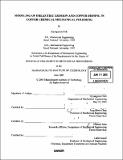Modeling of dielectric erosion and copper dishing in copper chemical-mechanical polishing
Author(s)
Noh, Kyungyoon
DownloadFull printable version (20.77Mb)
Other Contributors
Massachusetts Institute of Technology. Dept. of Mechanical Engineering.
Advisor
Jung-Hoon Chun and Nannaji Saka.
Terms of use
Metadata
Show full item recordAbstract
The phenomenal success in the manufacture of multi-layer, Ultra-Large-Scale-Integrated (ULSI) semiconductor devices is in part due to the local and global planarization capabilities of the chemical-mechanical polishing (CMP) process. At present, copper is widely used as the interconnect material in the ULSI technology. The greatest challenge in Cu CMP now is the control of wafer surface non-uniformity-primarily due to dielectric erosion and copper dishing at various scales--to within the ever stringent industry specifications. In this thesis, an integrated non-uniformity model is developed by combining wafer-, die- and feature-scale non-uniformities. A feature-scale pressure calculation scheme based on surface step-height is adopted, and the evolution of the surface in each polishing stage is modeled in terms of geometric, material and process parameters. Various pad/wafer contact mechanics regimes have been considered to model oxide erosion and Cu dishing, from submicron device level to the global wiring level. The plausible causes of erosion and dishing at wafer-, die- and feature-scales were identified and integrated into the feature-scale step-height models. Such parameters include: initial pattern geometry, wafer-scale uniformity, and Cu-to-oxide slurry selectivity, material properties, and surface topography of the pad. Based on the developed erosion and dishing models, the effects of model parameters on the wafer-surface non-uniformity in Cu CMP are discussed, and parameter sets to satisfy both dishing and erosion specifications are obtained. (cont.) In single-step polishing, for example, the Cu deposition factor should be less than 0.1 and the wafer-scale uniformity factor needs to be greater than 0.95 to maintain both erosion and dishing within 5% of interconnect thickness across the wafer if the polishing slurry has a selectivity of 15. Results of polishing experiments on 100 mm patterned Cu wafers validated both the step- height models and the integrated non-uniformity model. Based on the present models, erosion and dishing across the wafer was bounded by predefined parameters. Additionally, as predicted by the models, it was observed that the step-heights of the slowest and the fastest dies evolve in the ratio of the wafer-scale uniformity factor.
Description
Thesis (Ph. D.)--Massachusetts Institute of Technology, Dept. of Mechanical Engineering, 2005. Includes bibliographical references.
Date issued
2005Department
Massachusetts Institute of Technology. Department of Mechanical EngineeringPublisher
Massachusetts Institute of Technology
Keywords
Mechanical Engineering.